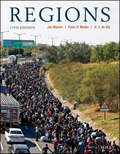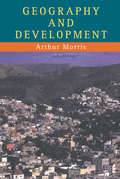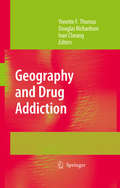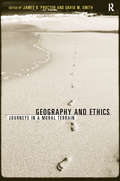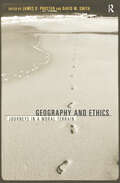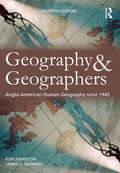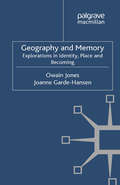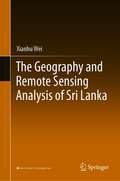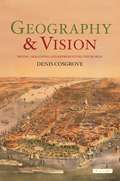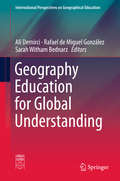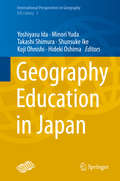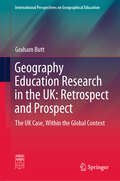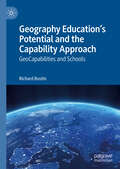- Table View
- List View
Geography: Realms, Regions, and Concepts
by Jan Nijman Peter O. Muller Harm J. de BlijWith exceptional content, the 17th edition of Geography: Realms, Regions, and Concepts, maintains its position as the market-leading world regional geography title, with a new twist—a new lead author and new contributors who bring fresh and modern perspectives. The new edition specifically brings emphasis to urban geography and spatial techniques through new content features and Geographic Information Analysis (GIA) Modules. With its refined narrative and dynamic resources, Regions provides a great digital experience, giving students the ability to learn and explore world regional geography both inside and outside of the classroom.
Geography 11-14 Advance Chapter: Why is disease a geographical issue?
by Rob Bircher John Hopkin and Gemma PollardThis advance chapter on the geographies of health and disease focuses on ideas including: •that disease (and health) have distributions in space, and can be examined at different scales •that the incidence of many diseases is related to environmental, economic and social conditions, as well as how people make decisions: the political sphere •that human progress has reduced the incidence and impact of many diseases, but not all, and new diseases are always possible in future.
Geography And Development
by Arthur MorrisFirst published in 1998. Routledge is an imprint of Taylor & Francis, an informa company.
Geography And Development
by Arthur MorrisFirst published in 1998. Routledge is an imprint of Taylor & Francis, an informa company.
Geography and Drug Addiction
by Yonette F. Thomas Douglas Richardson Ivan CheungMaking Connections: Geography and Drug Addiction Geography involves making connections – connections in our world among people and places, cultures, human activities, and natural processes. It involves understa- ing the relationships and ‘connections’ between seemingly disparate or unrelated ideas and between what is and what might be. Geography also involves connecting with people. When I rst encountered an extraordinarily vibrant, intelligent, and socially engaged scientist at a private d- ner several years ago, I was immediately captivated by the intensity of her passion to understand how and why people become addicted to drugs, and what could be done to treat or prevent drug addiction. Fortunately, she was willing to think beyond the bounds of her own discipline in her search for answers. Our conversation that evening, which began with her research on fundamental biochemical processes of drug addiction in the human body, evolved inevitably to an exploration of the ways in which research on the geographical context of drug addiction might contribute to the better understanding of etiology of addiction, its diffusion, its interaction with geographically variable environmental, social, and economic factors, and the strategies for its treatment and prevention. This fascinating woman, I soon learned, was Nora Volkow, the Director of the National Institute on Drug Abuse as well as the granddaughter of Leon Trotsky.
Geography and Ethics: Journeys in a Moral Terrain
by James D. Proctor David M. SmithThis book represents a landmark exploration of the common terrain of geography and ethics. Drawing together specially commissioned contributions from distinguished geographers across the UK, North America and Australasia, the place of geography in ethics and of ethics in geography is examined through wide-ranging, thematic chapters.Geography and Ethics is divided into four sections for discussion and exploration of ideas: Ethics and Space; Ethics and Place; Ethics and Nature and Ethics and knowledge, all of which point to the rich interplay between geography and moral philosophy or ethics.
Geography and Ethics: Journeys in a Moral Terrain
by James D. Proctor David M. SmithThis book represents a landmark exploration of the common terrain of geography and ethics. Drawing together specially commissioned contributions from distinguished geographers across the UK, North America and Australasia, the place of geography in ethics and of ethics in geography is examined through wide-ranging, thematic chapters.Geography and Ethics is divided into four sections for discussion and exploration of ideas: Ethics and Space; Ethics and Place; Ethics and Nature and Ethics and knowledge, all of which point to the rich interplay between geography and moral philosophy or ethics.
Geography and Geographers: Anglo-American human geography since 1945
by Ron Johnston James D. SidawayGeography and Geographers continues to be the most comprehensive and up-to-date overview of human geography available. It provides a survey of the major debates, key thinkers and schools of thought in the English-speaking world, setting them within the context of economic, social, cultural, political and intellectual changes. It is essential reading for all undergraduate geography students.It draws on a wide reading of the geographical literature and addresses the ways geography and its history are understood and the debates among geographers regarding what the discipline should study and how.This extensively updated seventh edition offers a thoroughly contemporary perspective on human geography for new and more experienced students alike.
Geography and Geographers: Anglo-American human geography since 1945
by Ron Johnston James D. SidawayGeography and Geographers continues to be the most comprehensive and up-to-date overview of human geography available. It provides a survey of the major debates, key thinkers and schools of thought in the English-speaking world, setting them within the context of economic, social, cultural, political and intellectual changes. It is essential reading for all undergraduate geography students.It draws on a wide reading of the geographical literature and addresses the ways geography and its history are understood and the debates among geographers regarding what the discipline should study and how.This extensively updated seventh edition offers a thoroughly contemporary perspective on human geography for new and more experienced students alike.
Geography and Memory: Explorations in Identity, Place and Becoming (Palgrave Macmillan Memory Studies)
by Owain Jones Joanne Garde-HansenThis collection shifts the focus from collective memory to individual memory, by incorporating new performative approaches to identity, place and becoming. Drawing upon cultural geography, the book provides an accessible framework to approach key aspects of memory, remembering, archives, commemoration and forgetting in modern societies.
Geography and Nationalist Visions of Interwar Yugoslavia (Modernity, Memory and Identity in South-East Europe)
by Vedran DuančićThis book is the first historical work to examine the notion of national territories in Yugoslavia – a concept fundamental for the understanding of Yugoslav history. Exploring the intertwined histories of geography as an emerging discipline in the South Slavic lands and geographical works describing interwar Yugoslavia, the book focuses on the engagement of geographers in the on-going political conflict over the national question. Duančić shows that geographers were uniquely equipped to address the creation of the new country and the numerous problems it faced, as they provided accounts of Yugoslavia’s past, present, and even future, all of which were understood as inherently embedded in geography. By analyzing a large body of geographical narratives on the Yugoslav state, the book follows both the attempts to “naturalize” and present Yugoslavia as a sustainable political and cultural unit, as well as the attempts to challenge its existence by pointing to unresolvable, geographically conditioned tensions within it. The book approaches geographical discourse in Yugoslavia as part of a wider European scientific network, pointing to similarities and specifically Yugoslav characteristics.
The Geography and Remote Sensing Analysis of Sri Lanka
by Xianhu WeiThis book presents a survey, dynamic monitoring and comprehensive analysis of Sri Lanka’s land, vegetation, surface water, ocean and other environmental resources, as well as its economic, transportation, urban, agricultural and tourism development. It offers readers accurate, systematic and comprehensive information on Sri Lanka’s ecological setting and socio-economic development. It also sheds light on policies for the protection of the environment and biodiversity.
Geography and Revolution (Science.culture Ser.)
by David N. Livingstone Charles W. J. WithersA term with myriad associations, revolution is commonly understood in its intellectual, historical, and sociopolitical contexts. Until now, almost no attention has been paid to revolution and questions of geography. Geography and Revolution examines the ways that place and space matter in a variety of revolutionary situations. David N. Livingstone and Charles W. J. Withers assemble a set of essays that are themselves revolutionary in uncovering not only the geography of revolutions but the role of geography in revolutions. Here, scientific revolutions—Copernican, Newtonian, and Darwinian—ordinarily thought of as placeless, are revealed to be rooted in specific sites and spaces. Technical revolutions—the advent of print, time-keeping, and photography—emerge as inventions that transformed the world's order without homogenizing it. Political revolutions—in France, England, Germany, and the United States—are notable for their debates on the nature of political institutions and national identity. Gathering insight from geographers, historians, and historians of science, Geography and Revolution is an invitation to take the where as seriously as the who and the when in examining the nature, shape, and location of revolutions.
Geography and Revolution
by David N. Livingstone Charles W. J. WithersA term with myriad associations, revolution is commonly understood in its intellectual, historical, and sociopolitical contexts. Until now, almost no attention has been paid to revolution and questions of geography. Geography and Revolution examines the ways that place and space matter in a variety of revolutionary situations. David N. Livingstone and Charles W. J. Withers assemble a set of essays that are themselves revolutionary in uncovering not only the geography of revolutions but the role of geography in revolutions. Here, scientific revolutions—Copernican, Newtonian, and Darwinian—ordinarily thought of as placeless, are revealed to be rooted in specific sites and spaces. Technical revolutions—the advent of print, time-keeping, and photography—emerge as inventions that transformed the world's order without homogenizing it. Political revolutions—in France, England, Germany, and the United States—are notable for their debates on the nature of political institutions and national identity. Gathering insight from geographers, historians, and historians of science, Geography and Revolution is an invitation to take the where as seriously as the who and the when in examining the nature, shape, and location of revolutions.
Geography and Technology
by Stanley D. Brunn Susan L. Cutter J. W. Harrington Jr.It is particularly appropriate that the AAG's Centennial Celebration should prompt the publication of a volume devoted to Geography and Technology. New technologies have always been important in advancing geographic understanding, but never have they been so thoroughly and rapidly transformative of the discipline as at this stage in geography's evolution. Just as new technologies have profoundly expanded both research possibilities and the knowledge base of other disciplines, such as biology, physics or medicine, so too are the revolutionary new geographic technologies developed during the past few decades extending frontiers in geographic research, education and applications. They are also creating new and resurgent roles for geography in both society and in the university. This trend is still accelerating, as the integration of geographic technologies, such as the global positioning system and geographic information systems (GPS/GIS), is creating an explosion of new "real-time, real-world" applications and research capabilities. The resultant dynamic space/time interactive research and management environments created by interactive GPS/GIS, among other technologies, places geography squarely at the forefront of advanced multidisciplinary research and modeling programs, and has created core organization management tools (geographic management systems) which will dramatically change the way governments and businesses work in the decades ahead. While these and other important geographic technologies, including remote sensing, location-based services, and many others addressed in this book, are forging new opportunities for geography and geographers, they also pose challenges.
Geography and Vision: Seeing, Imagining and Representing the World
by Denis CosgroveLeading geographer Denis Cosgrove provides a series of personal reflections on the complex connections between seeing, imagining and representing the world geographically. In a series of eloquent essays he draws upon pictorial images - including maps, sketches, cartoons, paintings, and photographs - to explore and elaborate upon the many and varied ways in which the vast and varied earth, and at times the heavens beyond, have been both imagined and represented as a place of human habitation. The essays include reflections upon geographical discovery; urban cartography and utopian visions; ideas of landscape and the shaping of America; wilderness and masculinity; conceptions of the Pacific; and the imaginative grip of the Equator. Extensively illustrated, this engaging work reveals the richness of the geographical imagination as expressed over the past five centuries.
Geography and Vision: Seeing, Imagining and Representing the World (International Library of Human Geography)
by Denis CosgroveVision and visual imagery have always played a central role in geographical understanding, and geographical description has traditionally sought to present its audience with rich and compelling visual images, be they the elaborate cosmographic images of seventeenth century Europe or the computer and satellite imagery of modern geographical information science. Yet the significance of images goes well beyond the mere transcription of spatial and environmental facts and today there is a marked unease among some geographers about their discipline's association with the pictorial. The expressive authority of visual images has been subverted, shifting attention from the integrity of the image itself towards the expression of truths that lie elsewhere than the surface. In Geography and Vision leading geographer Denis Cosgrove provides a series of personal reflections on the complex connections between seeing, imagining and representing the world geographically. In a series of eloquent and original essays he draws upon pictorial images - including maps, sketches, cartoons, paintings, and photographs - to explore and elaborate upon the many and varied ways in which the vast and varied earth, and at times the heavens beyond, have been both imagined and represented as a place of human habitation. Ranging historically from the sixteenth century to the present day, the essays include reflections upon geographical discovery and Renaissance landscape; urban cartography and utopian visions; ideas of landscape and the shaping of America; wilderness and masculinity; conceptions of the Pacific; and the imaginative grip of the Equator. Extensively illustrated, this engaging work reveals the richness and complexity of the geographical imagination as expressed over the past five centuries. It will appeal to all scholars with an interest in geography, history, art, landscape, culture and environment.
Geography, Art, Research: Artistic Research in the GeoHumanities (Routledge Research in Culture, Space and Identity)
by Harriet HawkinsThis book explores the intersection of geographical knowledge and artistic research in terms of both creative methods and practice-based research. In doing so it brings together geography’s ‘creative turn’ with the art world’s ‘research turn.’ Based on a decade and a half of ethnographic stories of working at the intersection of creative arts practices and geographical research, this book offers a much-needed critical account of these forms of knowledge production. Adopting a geohumanities approach to investigating how these forms of knowledge are produced, consumed, and circulated, it queries what imaginaries and practices of the key sites of knowledge making (including the field, the artist’s studio, the PhD thesis, and the exhibition) emerge and how these might challenge existing understandings of these locations. Inspired by the geographies of science and knowledge, art history and theory, and accounts of working within and beyond disciplines, this book seeks to understand the geographies of research at the intersection of geography and creative arts practices, how these geographies challenge existing understandings of these disciplines and practices, and what they might contribute to our wider discussions of working beyond disciplines, including through artistic research. This book offers a timely contribution to the emerging fields of artistic research and geohumanities, and will appeal to undergraduate and postgraduate students and researchers.
Geography, Art, Research: Artistic Research in the GeoHumanities (Routledge Research in Culture, Space and Identity)
by Harriet HawkinsThis book explores the intersection of geographical knowledge and artistic research in terms of both creative methods and practice-based research. In doing so it brings together geography’s ‘creative turn’ with the art world’s ‘research turn.’ Based on a decade and a half of ethnographic stories of working at the intersection of creative arts practices and geographical research, this book offers a much-needed critical account of these forms of knowledge production. Adopting a geohumanities approach to investigating how these forms of knowledge are produced, consumed, and circulated, it queries what imaginaries and practices of the key sites of knowledge making (including the field, the artist’s studio, the PhD thesis, and the exhibition) emerge and how these might challenge existing understandings of these locations. Inspired by the geographies of science and knowledge, art history and theory, and accounts of working within and beyond disciplines, this book seeks to understand the geographies of research at the intersection of geography and creative arts practices, how these geographies challenge existing understandings of these disciplines and practices, and what they might contribute to our wider discussions of working beyond disciplines, including through artistic research. This book offers a timely contribution to the emerging fields of artistic research and geohumanities, and will appeal to undergraduate and postgraduate students and researchers.
Geography Education for Global Understanding (International Perspectives on Geographical Education)
by Ali Demirci Rafael de Miguel González Sarah Witham BednarzThis book presents the core concepts of geographical education as a means of understanding global issues from a spatial perspective. It treats education, supported by high standards, approaches, methodologies, and resources, as essential in exploring the interactions of the world’s human and environmental systems at local, regional, and global scales embedded in the nature of the discipline of geography. It covers topics such as climate change, sustainable development goals, geopolitics in an uncertain world, global crisis, and population flows, which are of great interest to geography researchers and social sciences educators who want to explore the complexity of contemporary societies.Highly respected scholars in geography education answer questions on key topics and explain how global understanding is considered in K-12 education in significant countries around the globe. The book discusses factors such as the Internet, social media, virtual globes and other technological developments that provide insights into and visualization – in real time – of the intensity of relationships between different countries and regions of the earth. It also examines how this does not always lead to empathy with other political, cultural, social and religious values: terrorism threats and armed conflicts are also essential features of the global world. This book opens the dialogue for global understanding as a great opportunity for teachers, educators, scholars and policy makers to better equip students and future citizens to deal with global issues.
Geography Education in Japan (International Perspectives in Geography #3)
by Yoshiyasu Ida Minori Yuda Takashi Shimura Shunsuke Ike Koji Ohnishi Hideki OshimaIn a globalized market where the emerging workforce will increasingly travel within their nations and abroad for work opportunities, it is valuable to learn about the international education system and practices, to assess the competition. For example, annual comparison of student performance is measured across math and science subjects globally. What is not well known is how geography educational systems compare around the world and how student success in this subject translates to learning in other courses or employment after graduation. The importance of geography in our personal, professional, and civic lives is transparent when one considers how finding one’s way with a map, understanding of world cultures, or identifying spatial patterns of disease spread might influence the decisions we make. Written for a global audience, this is the first English publication on geography education in Japan, addressing some fundamental questions. What is the nature of the geography educational systems in Japan? How does the focus on content and skills in Japanese schools differ from that in other countries? This book includes 25 authors from diverse geography instruction and research experiences, making it an authoritative publication on Japan’s geography education system. The contribution of this book to the larger geography educational community is sharing the key strengths, concerns, and future of this school subject in English, where previously most publications were in Japanese. It will be a useful source for researchers and teachers to understand Japan’s evolving geography instruction in the past, present, and future. The 21 chapters are organized into themes, beginning with an overview of the geography education system in Japan, followed by chapters that deal with regional geography and fieldwork, teacher training, geography education’s contributions to society, and a comparative study of geography education across multiple countries. The book ends with a vision of geography education in the future.
Geography Education Research in the UK: The UK Case, Within the Global Context (International Perspectives on Geographical Education)
by Graham ButtThis book provides a unique assessment of the development of research in geography education and its future prospects, offering a challenging critique of subject-based education research, with particular reference to geography education across a range of different jurisdictions. It covers a range of topics, including the changing role of research in geography education; the relationship between education research and professional practice, with special reference to geography education research; the place of academic subject knowledge in geography education research; critiques of the functions of research in geography education; and the key issues for education policy and policymakers concerning educational research at national and international levels.Importantly, in a period marked by radical change for education research and researchers, the book offers a timely appraisal of possible ways forward for geography education research. Addressing the needs of academics, research students, policymakers, and education practitioners who undertake, use or shape the future of research in geography education, it comprehensively explores the forces that have driven the development of geography education research and pedagogy. Further, by positioning its analysis in the context of education policy debates in the UK, and further afield, it assesses the role and function of research in education, and offers an outlook on its future. This book is essential reading for all those who wish to understand the sporadic and increasingly uncertain development of subject-based research in education
Geography Education's Potential and the Capability Approach: GeoCapabilities and Schools
by Richard BustinThis book explores the pivotal role that geography as a school subject plays in helping every young person achieve their educational potential. Expressed as ‘GeoCapabilities’, this concept draws on the the capabilities approach developed by Amartya Sen and Martha Nussbaum applied to curriculum thinking in schools. While traditional subjects have often been deemed irrelevant and outdated in an overcrowded secondary school curriculum, subjects like geography have often been lost or combined with others to fulfil a broad skills agenda. More recent talk of a ‘knowledge led’ curriculum can often lead to the recitation of facts at the expense of developing deeper understanding. This book argues the concept of powerful geographical knowledge, based on the work of Michael Young and David Lambert, invests the subject of geography with its educational potential: this forms the basis of GeoCapabilities. GeoCapabilities focuses on both what is being taught and why, and as such provides a framework of curriculum thinking which will be of interest and value to geography teachers, school leaders with curriculum development responsibilities and all those interested in the capability approach and the moral imperative of education.
Geography for Cambridge International AS & A Level
by David Kelly Muriel Fretwell John NansonBuild geographical skills for the latest Cambridge AS and A Level exams, and a solid foundation for university. Geography for Cambridge International AS & A Level includes plenty of practice, encouraging students to apply skills in context. Online access to exam practice and strategies is also available.
Geography for CCEA A2 Level (2nd Ed)
by Martin Thom Eileen ArmstrongThis resource has been comprehensively updated to cover all eight options of Units A2 1 and A2 2 of the revised CCEA A2 Geography specification. It has been through a thorough quality assurance process and is endorsed by CCEA.
